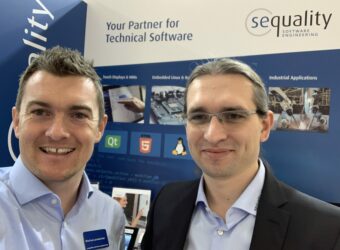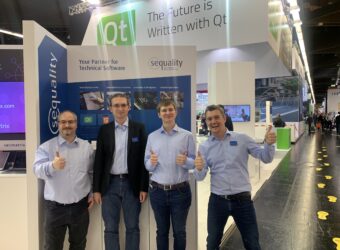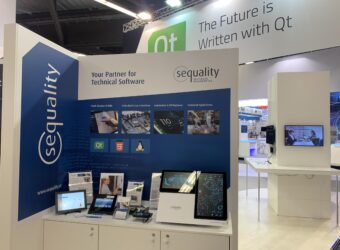Many innovative providers of embedded software, electronics, automation and software services with a strong European background were forming part of the event. They all were in need of a presence on a fair like the Embedded World in order to present their solutions to new customers. In this respect, sequality was happy to present the latest embedded software solutions at our booth, see this blog post for details.
From our point of view, the following topics raised a lot of attention at the Embedded World 2020:
Qt-on-Microcontroller
At the Embedded World, it happened for the first time that Qt-on-Microcontroller was presented to a wider audience. The Qt-based demos that were presented ranged from microcontroller-based coffee machines to small, interactive smart watches featuring a tiny, round display. Many people were curious about whether existing Qt applications could be transmitted to Qt-on-Microcontroller. As the existing documentation currently shows, Qt-on-Microcontroller only offers a special range of QML-based components that can be rendered on a microcontroller. None of the Qt standard classes (QProcess, QFile, QCanBusDevice,…) or more complex QML components (Qt virtual keyboard) are available on Microcontroller. This makes sense, as Qt standard classes need a posix-compatible operating system in order to work on the underlying operating system. In this respect, we would like to point out that Qt-on-Microcontroller runs „bare metal“ without an operating system. In our point of view, the great strength of Qt-on-Microcontroller is the fact that the QML knowledge and development skill set of an existing software development team can be reused in case a company already relies on Qt within their product line.
See my live video from the Embedded World on Qt on embedded Linux and Qt-on-Microcontroller.
Efficient, powerful hardware
Many NXP i.Mx8, i.Mx6UL and i.Mx7 chips were seen on embedded Linux-based demos. But also ST and Renesas were widely used for various industry and automotive demos. It seems like i.Mx8 has finally managed to reach a wider audience on the market, as many companies presented small i.Mx8-based boards and demonstrations.
Embedded Linux connected to the cloud
Various hardware vendors presented ideas on how to connect embedded Linux-based components to the cloud in order to perform „over-the-air updates“ (OTA updates) and organize applications in containers which isolate the applications from the kernel, but still offer access to hardware acceleration. One example is the embedded Linux Torizon by Toradex, offering this functionality built with Yocto (see a link here).
AI and embedded vision
In the future, we believe that a bigger amount of artificial intelligence solutions embedded in hardware will be developed. Comprehensive AI libraries like „TensorFlow“ are already incorporated into embedded devices with a local Tensor Processing Unit (aka TPU ) hardware support. Combined with cameras and robust environment sensors of all kinds, applications related to autonomous driving, predictive maintenance and human-machine-interaction will be further improved in the future.
All in all, the Embedded World 2020 had a different flavor this time: The various locations of the event were less crowded, providing more time to network and to go in-depth when discussing the solutions provided by mid-sized innovative companies.


